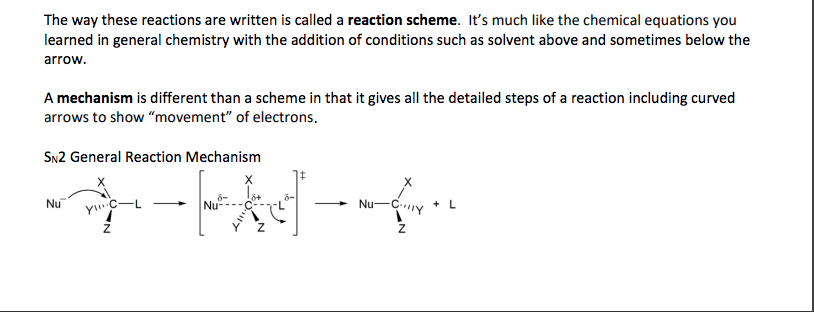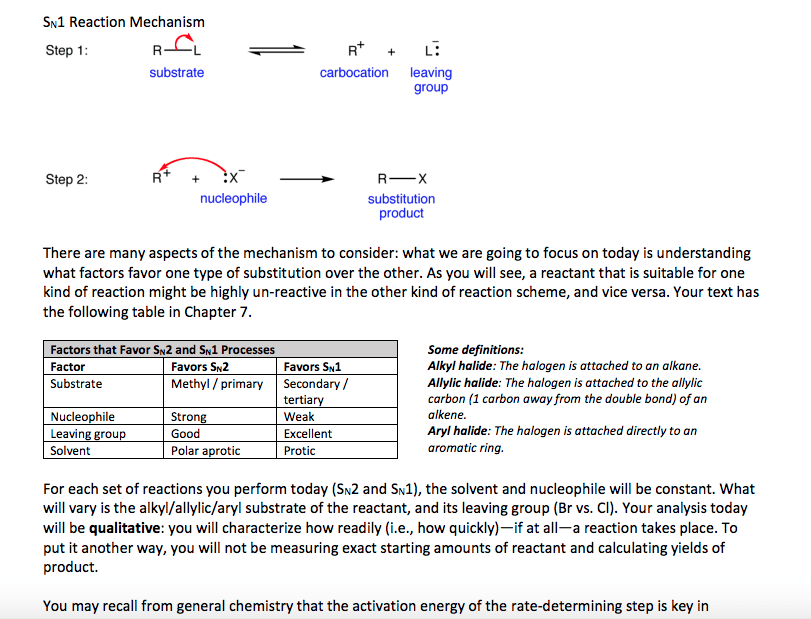CHE 201LLR Lecture Notes - Lecture 9: Nucleophilic Substitution, Leaving Group, Alkoxide

Chapter 9: The Chemistry of Alkyl Halides
Nucleophilic Substitution Reactions
- Nucleophilic substitution reactions a nucleophile substitutes for a leaving group
o 𝑆𝑁1: two-step process going through a carbocation
o 𝑆𝑁2: one step process
- 𝑆𝑁2 is the simplest type where a nucleophile attacks an electrophilic carbon and displaces
a leaving group
- Reactions can be intermolecular (between two molecules) or intramolecular where the
nucleophile and electrophile are in the same molecule
o Intramolecular reactions will form a ring
𝛽-elimination Reactions
- In elimination reactions two or more groups are lost within the same molecule
o 𝛽-elimination reactions form a double bond
▪ Two groups that are lost are on adjacent carbons
- Strong bases promote 𝛽-elimination reactions of alkyl halides
- Alkoxides are strong base used often in examples
- A hydrogen atom from any 𝛽-carbon could be deprotonated for form an alkene product
o Up to three products could form

Substitution vs Elimination
- Nucleophilic substitution and 𝛽-elimination reactions often compete with one another
o Which is the major product will be determined by several factors to include:
▪ Strength and size of base
▪ Classification of leaving group
▪ Strength of nucleophile
Equilibria in Substitution Reactions
- How do we know whether the equilibrium for a given substitution reactions is favorable?
- Each nucleophilic substitution reaction is similar to Bronsted-Lowry acid-base reaction
- The equilibrium in nucleophilic substitution reaction favors the release of the weaker
base
- Le Chatelier’s principle can be used to drive some unfavorable equilibria
- Typically, iodide, the beaker base, cannot replace chloride
o In acetone (solvent), alkyl chlorides and KI are soluble, but KCl is not
o The reactions proceeds in the forward direction trying to replace the “lost” KCl
Definition of Reaction Rates
- The equilibrium constant for a reaction will tell you nothing about how fast the reaction
will occur
- The concentration of reactant and product are the quantities that change over the course
of a reaction
The Rate Law
- The rate law expresses how fast a reaction will occur
o Dependent upon concentration of reactants
o Is determined experimentally
o For example: Rate = k[A][B]
▪ Overall this example is second order (kinetic order)
▪ First order in [A] and first order in [B]
Rate Constant and ∆𝐺°
- The energy barrier determines the
rate of reaction under standard
conditions
- Rate constant is related to the
standard free energy of activation
∆𝐺°
- We are usually more interested in
relative rates of two reactions

The 𝑆𝑁2 vs Bronsted-Lowry Reaction Rates
- Most ordinary acid-base reaction occur instantaneously
- Most nucleophilic substitution reactions are much slower
- If there is competition, the acid-base reaction always wins
The 𝑆𝑁2 Reaction
- The rate law tells us which molecules are involved in the rate determining step, but now
how they are arranged
- There are two possible arrangements that would allow for a second order reaction
Stereochemistry of the 𝑆𝑁2 Reaction
- Experimental results show inversion of stereochemistry
- Seen in all 𝑆𝑁2 reactions at carbon stereocenters
o R/S switch occurs IF the leaving group and nucleophile are same priority
- The transition state is a pentavalent carbon where the nucleophile and leaving group are
180º apart and the other groups (R1,2,3) are planar




